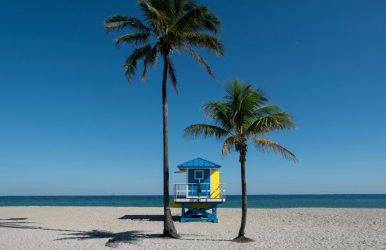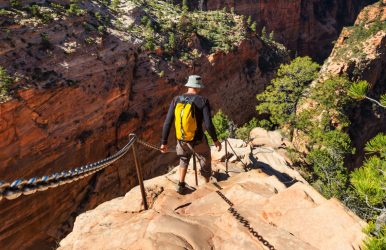Best Beachfront RV Parks In Florida: Directory Picks For Ocean Lovers
BY Barsha Jun 19, 2025
For RV enthusiasts, Florida's extensive coastline offers a haven of beachfront parks that perfectly combine the natural beauty of the ocean with the comforts of modern amenities. Imagine parking your RV just steps away from pristine beaches, where you can listen to the soothing sound of waves and feel the warm sand under your feet. Many of these parks provide easy access to outdoor activities such as swimming, fishing, and beach combing, making them ideal destinations for relaxation and adventure. What Are The Best RV Parks In Florida? With various parks ranging from the Panhandle to the Atlantic Coast, there's a perfect spot for every traveler seeking the unique charm of Florida's beachfront locations. 1. Sunshine Key RV Resort And Marina The Sunshine Key RV Resort and Marina has a beautiful scenic beauty that won’t disappoint you at all. Located in Ohio Key, it is a slice of heaven on Earth. Top Features Ocean views Private Marina Full-Hookup space Resort-style pool Pet-Friendly Benefits You will enjoy fishing and boating Ample amount of space for big rigs Easy access to water sports Welcoming community Pet-friendly policies Best For Oceanfront living RV enthusiasts craving luxury living Cons The place is occasionally overcrowded It has premium pricing 2. Bluewater Key RV Resort The Bluewater Key RV Resort brings opulence and seclusion together with a lush and thoughtfully decorated private space. Top Features Private docks are available Each site has tiki huts They have upscaled facilities The landscape provides privacy Pet-friendly Benefits Exclusive waterfront access A serene environment Personalized space Plentiful wildlife sightings Proximity to Key West Best For Campers have a tranquil and premium RV experience Cons Reservations fill up fast Has a high price range 3. Boyd’s Key West Campground If you are looking for a beckoning adventure at one of the best RV parks in Florida, then look no further than Boyd’s Key West Campground, at the southern edge of the United States. Top Features Heated pool Tiki hut picnic area Waterfront sites Fishing pier 24-hour security Benefits Water-based activities on-site A pet-friendly atmosphere Quick access to Key West Variety of site options Full-service amenities are available Best For Best for outdoor fun Excitement of the Key West attractions Cons It is noisy due to the proximity to Key West There is a lack of privacy 4. Bahia Honda State Park For all the nature lovers out there, the best park for you is the Bahia Honda State Park, with its numerous water sports for you to enjoy as well. Top Features Snorkeling opportunities Marina services Pristine beaches Nature trails Historic bridge views Benefits Abundance of marine life Direct beach access Picturesque surroundings Quite environment Opportunities for stargazing Best For Great for nature buffs Great fun for water sports lovers Looking for tranquil beachfront camping experience Cons Limited space during peak season Strict regulations for pet access 5. Fiesta Key RV Resort And Marina If you are looking for the perfect tropical getaway then look no further than Fiesta Key RV Resort and Marina. Top Features Oceanfront sites Full-hookup capabilities Resort-style pool Marina with boat slips On-site restaurant and bar Benefits Engage in social events Dine without leaving the resort Enjoy fishing and boating Experience waterfront living Access all-encompassing amenities Best For Self-contained resort experience Lots of things to do and social opportunities Cons Higher cost for self-contained resort experience Mostly busy and less privacy 6. Leo’s Campground – Key West's Hidden Gem Looking for a budget-friendly getaway, kept hidden like a jewel with all the genuine Key West culture, then you need to visit Leo’s Campground. Top Features Waterfront and shaded sites Close to Key West Community experience Competitive pricing Free Wi-Fi Benefits Easy access to local attractions Intimate camping grounds Significant cost savings Friendly staff A cozy vibe Best For Close proximity to Key West’s lively downtown Budget-conscious travelers Cons Fewer amenities compared to others Smaller in size 7. Big Pine Key Fishing Lodge For the Anglers and their families, the Big Pine Key Fishing Lodge is among the best RV parks in Florida, with dockside amenities, and welcoming ambiance. Top Features Boat ramp access On-site fishing options Bait and tackle shop Heated pool Waterfront lodging Benefits Family-friendly environment Variety of lodging options Great for fishing Engaging community events Easy boating Best For Activity-rich Nautically themed camping experience Great for families and anglers Cons Since popular, hard to get in Fishing focused so might not appeal to everyone 8. Jolly Roger RV Park And Resort If you are looking for a stunning oceanfront view right from your RV, then the Jolly Roger RV Park is the one for you. Top Features A plethora of activities Pet-friendly Sunset viewpoints Oceanfront sites Very welcoming staff Benefits The sound of waves wakes you Stunning sunset views Engaging water sports and other activities Pet-friendly environment Very friendly community Best For Activity rich atmosphere Great for RV campers looking for ocean access directly Cons Limited privacy in the camp site During peak season it is packed 9. Grassy Key RV Park & Resort If you want to experience a serene, tailored intimate camping atmosphere, then Grassy Key RV Park and Resort is the one for you. Top Features Stunning ocean view access Secluded Pet-friendly Access to private beaches Full hookup utility Inviting community areas Benefits Bask in the natural surroundings Pets are welcomed to accompany Personal space away from crowds Convenient amenities Access private beaches for leisure time Best For Campers looking for some peace and quiet Scenic getaway with your pets To relax and unwind by the water Cons A bit remote compared to other tourist spots Less on-site activities compared to large parks 10. Key Largo Kampground And Marina Here at Key Largo Kampground you are gonna camp in style with a diverse community and superb areas for fishing and coral reefs. Top Features Wide range of site options Marina access Swimming pool access Beach area access Get kayak rentals Benefits Can accommodate RVs of different sizes and styles It has direct access to water activities Multiple pools for swimming Wildlife sighting opportunities A fun family and friendly environment Best For Diverse groups are welcomed Family friendly communal atmosphere Have direct access to Key Largo’s aquatic activities Cons It gets very busy during peak seasons The premium sites can be costly The Ultimate Best RV Parks In Florida For a smooth experience, the Fireflies and Campfires Florida RV Directory is helpful for reading reviews and gathering tips from other travelers. Prepare your RV by checking all systems, including water, electricity, and waste disposal. Ensure a first aid kit and basic tools are on hand for any minor repairs. Taking these steps ensures you're ready for the journey and the stay at your beachfront destination. No matter which park you choose, Florida's beachfront locations provide a wonderful mix of natural beauty and opportunities for fun. Whether savoring a quiet moment by the ocean or enjoying activities with your loved ones, the right RV park will help you create lasting memories.











